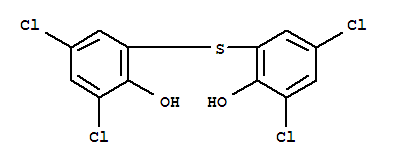| Identification |
| Name: | Phenol,2,2'-thiobis[4,6-dichloro- |
| Synonyms: | 2,2'-Dihydroxy-3,3',5,5'-tetrachlorodiphenylsulfide; 2,2'-Thiobis(4,6-dichlorophenol); 2-Hydroxy-3,5-dichlorophenyl sulphide;Actamer; Bidiphen; Bis(2-hydroxy-3,5-dichlorophenyl) sulfide; Bisoxyphen;Bithin; Bithionol; Bitin; Bitionol; CP 3438; D 26; Lorothidol; Lorothiodol; NSC47129; NSC 9872; Neopellis; Nobacter; TKhSD; Vancide BL; XL 7 |
| CAS: | 97-18-7 |
| EINECS: | 202-565-0 |
| Molecular Formula: | C12H6Cl4O2S |
| Molecular Weight: | 356.04 |
| InChI: | InChI=1/C12H6Cl4O2S/c13-5-1-7(15)11(17)9(3-5)19-10-4-6(14)2-8(16)12(10)18/h1-4,17-18H |
| Molecular Structure: |
 |
| Properties |
| Transport: | UN 2811 |
| Melting Point: | 188 ºC |
| Density: | 1.61 |
| Stability: | Stable. Incompatible with strong oxidizing agents. |
| Water Solubility: | | <0.1 g/100 mL at 23 ºC |
| Solubility: | <0.1 g/100 mL at 23 ºC |
| Appearance: | White or grayish-white, crystalline powder. Odorless or with slight aromatic or phenolic odor. |
| Specification: |
2,2'-Thiobis(4,6-dichlorophenol) (CAS NO.97-18-7) is incompatible with acids, diazo and azo compounds, halocarbons, isocyanates, aldehydes, alkali metals, nitrides, hydrides, and other strong reducing agents. Reactions with these materials may generate heat and toxic or flammable gases. Bithionol is a skin irritant. When heated to decomposition or upon contact with acid or acid fumes, toxic fumes are evolved.
|
| Report: |
Chlorophenol compounds are on the Community Right-To-Know List. Reported in EPA TSCA Inventory.
|
| Packinggroup: | II |
| Storage Temperature: | 0-6°C |
| Color: | White or grayish-white, crystalline powder |
| Usage: | Surfactant-formulated antimicrobial against bacteria, molds and yeast. |
| Safety Data |
| Hazard Symbols |
 Xn: Harmful
Xn: Harmful
|
| |
 |